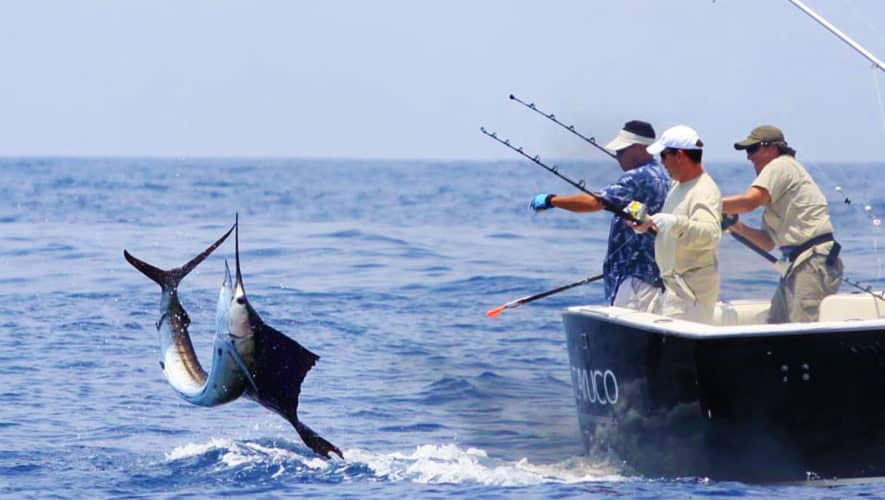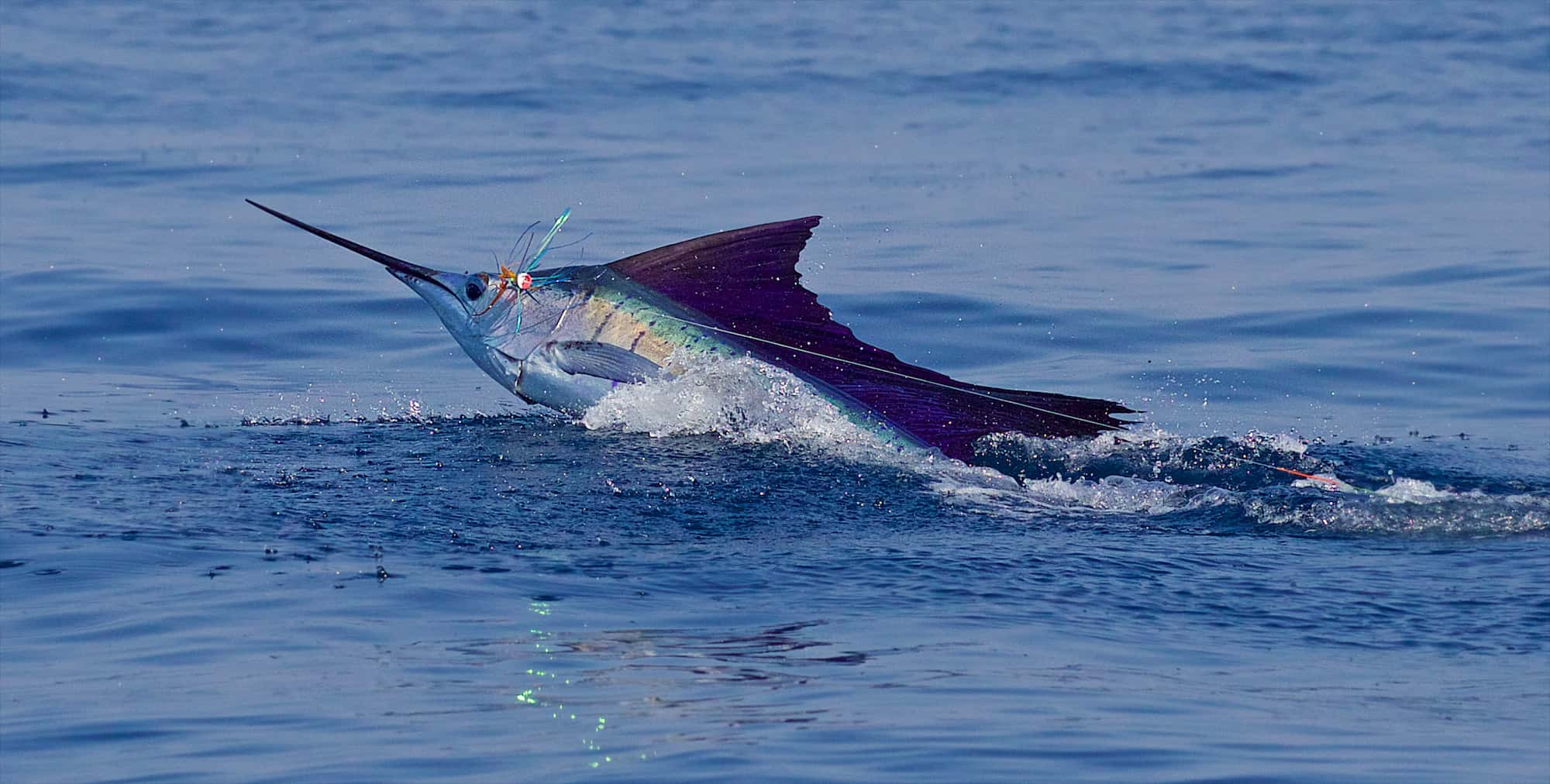I’ve never been one to be afraid or too proud to ask for help. Some things I don’t understand, and with others I’m all thumbs. That’s why I’ve always kept close friendships with boat mechanics, fishing guides, reel repair people, doctors, scientists and even shrinks. I’ve wondered for some time what makes Central America so special when it comes to sailfish.
Why does the season peak from December through April? Why are the fish so big in Costa Rica, and why don’t we catch juvenile fish? Where do the fish go at the end of the season? Do they go offshore or do they go south or north?
A few months ago, Dr. Nelson Ehrhardt from the University of Miami and scientific adviser to the Central American Billfish Association (CABA) contacted me and asked if I could share my data collected from operating the largest billfishing resort in Central America for the past 10 years. I gladly agreed, and learned he had been doing an extensive study in Mexico and Central America for the last two years.
Each meeting with him in San José and at the resort in Puerto Jiménez, I learned a little more about blue-water ballerinas. It’s amazing how professionals can put all kinds of stuff in perspective and make it understandable. Dr. Ehrhardt should write “Sailfish for Dummies.”
The same population of sailfish – pez vela in Spanish – traverses the eastern tropical Pacific from southern Mexico to Ecuador. It is one of the most condensed sailfish populations in the world. The lifetime of a sail is 10 to 15 years. Most of the juveniles spend their first few years off the coast of Mexico.
That doesn’t necessarily mean they were born there. For example, a west coast Florida tarpon starts its life 100 miles or so off the beach, but spends its early years in the estuaries. The largest sailfish and the long-standing world record of 222 pounds came from their farthest range to the south in Ecuador.
The tropical Pacific is really not a very inviting place for sailfish. The low oxygen content in the water will not support them, but two famous currents bring in healthy water. The Humboldt Current flows north from Chile and Peru and collides with the California Current flowing south from the U.S. and Mexico off the coast of Central America, forming a “tongue” of current that supports sailfish, though to a depth of only 100 meters or less.

Unlike the striped marlin that is caught off Mexico but might spawn off Australia, the eastern tropical sailfish’s range is limited to the coastal waters of the two currents and the tongue formed off Central America.
Another phenomenon happens each year: Three distinct and powerful winds blow from land offshore. They start in December or January and blow until March or April. In Mexico, winds that start in the Gulf of Mexico push across the Tehuantepec lowlands offshore into the Pacific. Likewise, the Papagayo winds from Lake Nicaragua push offshore across Nicaragua near the Costa Rican border. Also, a Caribbean wind current crosses Panama heading into the Pacific near the Panama Canal.
As the Pacific surface water is pushed offshore, the upwelling sends to the surface oxygen-depleted water that cannot support sailfish. The entire population is forced into pockets of healthy water, which happen to lie in front of windless parts of southern Mexico, Guatemala, Costa Rica and parts of Panama.
During this period, El Salvador, Nicaragua and other parts of Panama are nearly devoid of sailfish. This is the equivalent of taking the entire population of San José and moving everybody to the Pacific coast for four months out of the year, with no one living in between. Fortunately for the sailfish, their main food source, squid and sardines, follow the same pattern.
The reality is that these areas do not have a tremendous abundance of fish, but the whole population is forced to share these pockets. When there is a strong El Niño, the winds do not blow, so the population is not condensed into oxygen-healthy pockets caused by the normal upwelling. The surface waters also warm, and peak-season fishing results in Guatemala and Costa Rica drop dramatically.
Costa Rica has the benefit of two peak sailfish seasons. From the Gulf of Nicoya south, the peak is January through April. The Guanacaste region to the north begins to peak in May after the winds die and the fish begin to move freely out of prisons formed in Guatemala and southern Costa Rica.
Dr. Ehrhardt’s studies have shown that a strong management plan is needed with all Central American countries working together. The Costa Rican Tourist Fishing Federation (FECOP) is working with sport and commercial fishermen and the government on management plans within Costa Rica. In addition, CABA, The Billfish Foundation and local groups are working with Central American governments to form a united effort to conserve the region’s sailfish populations.
So now I’m standing on the stern of this boat with half a chicken’s worth of pink-dyed feathers and a fly rod in my hand, waiting for a ballerina to pop up, mulling over everything I learned about sailfish. If anyone has any advice on how to make a sailfish a dummy, I’m all ears!
About Todd Staley
He was in the fishing business in Costa Rica for nearly 20 years, covering both coasts. He started out at Río Colorado Lodge on the northern Caribbean coast and was the director of fishing at Crocodile Bay Resort, on southwestern Costa Rica’s Osa Peninsula, since its inception.
He was president of the Costa Rican Tourist Fishing Federation (FECOP), which is made up of associations from around the country, he was active in marine conservation issues and lobbying for more sustainable fishing laws in Costa Rica. FECOPT recently spearheaded the effort to declare the Golfo Dulce the largest “responsible fishing area” in Central America (TT, June 11).







